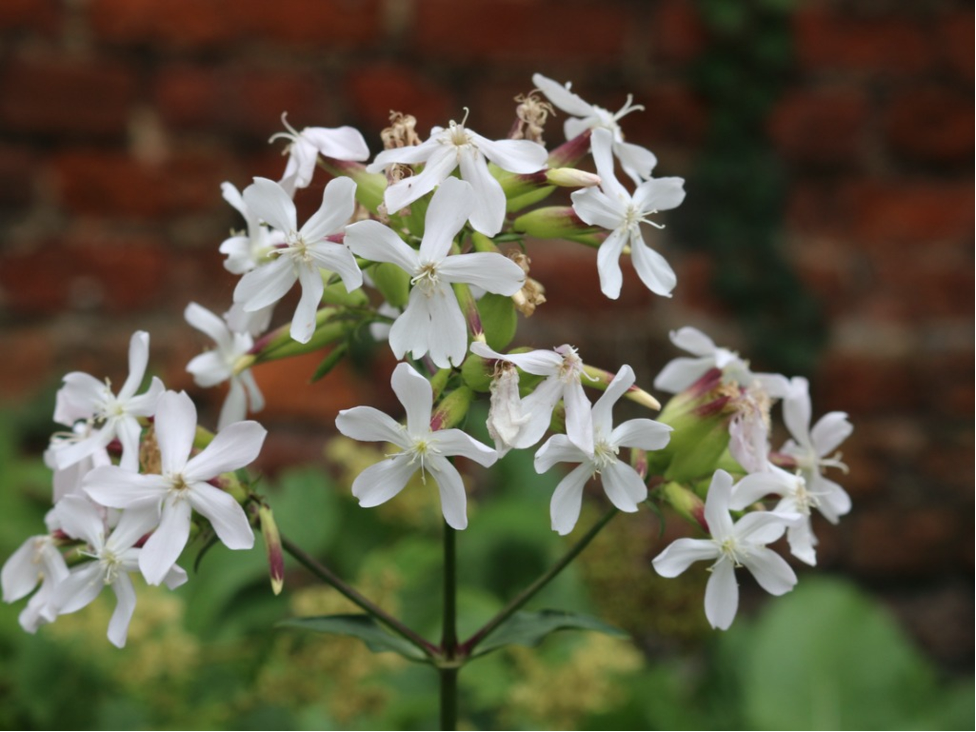There have been many explanations for how the Shroud of Turin came to be marked with the image of a man in negative. For hundreds of years, some Christians believed that the spectral imprint was left on the scrappy length of medieval linen by Christ’s crucified body. More recently, historians and scientists have speculated that the figure might have been painted on with tempera or acid, or marked out by dust or sunlight. One theory involves Saponaria officinalis, or soapwort, a plant which was historically used as a detergent for delicate cloths. If soapwort was used to treat the linen, it may have helped to preserve the shroud, or even to create the image. There’s some soapwort growing in the Barber-Surgeons’ garden now, but it’ll grow almost anywhere in full sun. Despite being native to Europe and Asia, soapwort has even managed to break New York, where it’s easy to spot, and where its wide-open white flowers and honeyish scent attract moths to the piles of building-site rubble that it makes home.
It’s the chemical saponin, deriving from the Latin sapo meaning “soap,” which gives soapwort both its name and its usefulness in gently lifting dirt from textiles. Other nicknames are in a similar vein: crow soap, soapweed, or bouncing-bet (“Bet” was an eighteenth-century slang term for barmaids who, supposedly, would clean pint glasses with water and a sprig of soapwort). There are plenty of soapwort-based soap recipes online, the simplest of which involves chopping the leaves, boiling them for about half an hour, and and straining the liquid. Unlike the more commonly-used soaps that were produced from animal fat and lye before synthetic methods took over, soapwort produces a very soft, fine lather, which made it suitable for washing wool, and more recently for cleaning old and fragile tapestries.
Many early modern mentions of soapwort, though, suggest using it for the body or in the bath, rather than on cloth. Robert Permell’s 1650 Ptochopharmakon, a medical handbook, suggests that we “bath with it” as a remedy “against the itch and scab.” Similarly, Johann Jacob Wecker’s 1660 Cosmeticks, a more aesthetically-minded collection of hair and skin remedies, suggests the following recipe for “A stronger Bath for faults of the Skin”:
“Take of the roots of Lillies, Grass-plantane, Bryony, each one pound, Burrage, Bugloss, Fumitory, Sope-wort, each two handfulls, Pellitory of the Wall, Maidenhair, Mallows, Violet leaves, each one handful; whole Barley, Beans blanched, Rice, each three ounces; Flowers of Melilot, Chamemel, Rosemary, Mallowes, Violets, each two pugils; roots of Orrice, Niter, each a sufficient quantity, make a Decoction for a Bath.”
The injunction to wash our hands with soap and water is seared into my mind from the earliest weeks of the pandemic. Photos on my phone from this time last year show my hands chapped and raw. One of my personal “so this really is happening” moments last year was the March evening I spent wandering between Boots outlets, trying and failing to buy soap or hand sanitiser. There’s a certain kind of Dettol hand soap which I don’t think I’ll ever be able to smell again without feeling mildly stressed out. A year later soapwort, with its fresh-linen scent now reminding me of Wecker’s extremely pleasant-sounding herbal bath, has gone some way to recuperating soap as something softer, gentler, and more soothing.






Soap can also be made from Horsechestnut conckers nuts, have done it with some success. Horsechestnut is also medicine for veinous issues which I have; funny how the plants know, or in this case maybe I was attracted to move here because of that (very messy and hard to garden under) tree, because I need it. (Tinctured for use). Best and thanks again; ps I cannot use any soaps that have crap ingredients, especially the OXY brand dishsoaps, they smell so very wrong to me....just the plants, thanks, right?